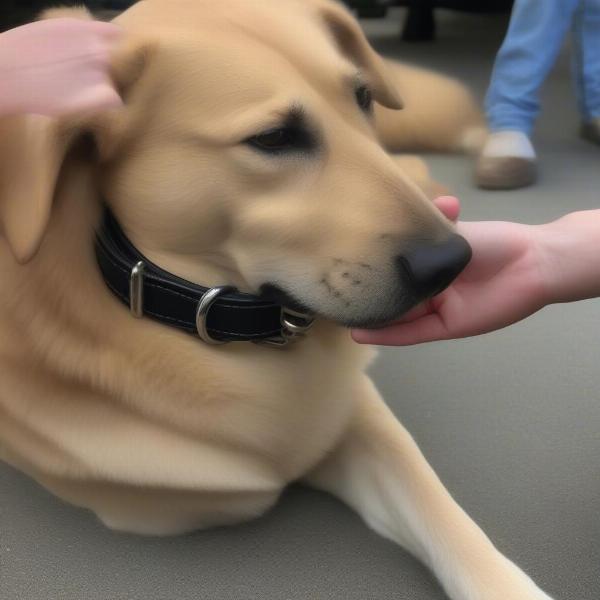Locking dog collars, also known as martingale collars or limited-slip collars, offer a secure and humane alternative to traditional collars, especially for dogs prone to slipping out of their regular collars. They provide more control without the choking hazard of a choke chain. But are they right for your dog? This guide will delve into the world of locking dog collars, covering their types, benefits, proper usage, and important safety considerations.
Types of Locking Dog Collars
Locking dog collars come in various styles. The most common is the martingale collar, featuring a loop that tightens when the dog pulls, preventing escape. These come with either a chain loop or a fabric loop. Chain martingales offer more precise control, while fabric versions are gentler on the dog’s fur. There are also limited-slip collars that function similarly but often have a buckle or other locking mechanism.
Benefits of Using a Locking Dog Collar
A locking dog collar offers several advantages, particularly for dogs who are escape artists or have slender necks. The controlled tightening action provides a clear signal to the dog when they are pulling, discouraging this behavior without choking. They’re especially useful for training and walking dogs who are easily distracted or reactive.
 Dog Wearing a Locking Dog Collar Correctly
Dog Wearing a Locking Dog Collar Correctly
How to Properly Fit and Use a Locking Dog Collar
Proper fit is crucial for the effectiveness and safety of a locking dog collar. The collar should be snug enough that it won’t slip over the dog’s head but loose enough to allow two fingers to fit comfortably between the collar and the dog’s neck. When the dog pulls, the collar should tighten just enough to prevent escape, not to choke. Regularly check the fit, especially for growing puppies. Never leave a locking collar on an unsupervised dog, particularly when crated, as it poses a strangulation risk.
Safety Considerations for Locking Dog Collars
While locking dog collars offer many benefits, it’s essential to use them responsibly. Avoid using them on dogs with respiratory issues or neck injuries. Never attach a leash to a locking collar intended only for identification tags. Incorrect usage or a poorly fitted collar can lead to injuries.
Is a Locking Dog Collar Right for My Dog?
Whether a locking dog collar is suitable for your dog depends on several factors, including their breed, temperament, and training needs. Consult with a certified dog trainer or veterinarian for personalized advice. They can help you determine if a locking dog collar is the right choice for your dog and guide you on proper usage.
Choosing the Right Locking Dog Collar
When choosing a locking dog collar, consider the material, size, and locking mechanism. Opt for high-quality, durable materials and a size appropriate for your dog’s neck. If you’re unsure about the right type or size, seek professional guidance. locking dog door can be a great addition to your home if you have a dog.
Training with a Locking Dog Collar
Locking dog collars can be helpful training tools, but they should be used in conjunction with positive reinforcement methods. The collar should serve as a communication tool, not a punishment device. indoor pet fence for dogs is a good choice for training.
“Locking dog collars, when used correctly, are a valuable tool for both safety and training,” says Dr. Emily Carter, DVM, a veterinary behaviorist. “They offer a humane alternative to traditional collars for dogs prone to slipping out, providing better control and preventing escapes.”
“Remember, a well-fitted collar is paramount for safety,” adds Lisa Miller, a certified professional dog trainer. “It should be snug but not restrictive, allowing for comfortable movement without choking.” dog in a doublet lock can be helpful.
Conclusion
Locking dog collars offer a safe and effective way to manage and train your dog, especially for those prone to escaping. However, responsible usage and proper fit are crucial. Consider your dog’s individual needs and consult with a professional for personalized advice. itching dog medication can be used for dogs. Choosing the right collar and using it correctly can significantly enhance your dog’s safety and well-being. carabiner dog lead is another helpful tool for walking your dog.
FAQ
-
Can I leave a locking dog collar on my dog all the time? No, it’s not recommended to leave a locking dog collar on your dog unsupervised, especially when crated, due to the risk of strangulation.
-
Are locking dog collars suitable for all dog breeds? While generally safe for most breeds, they may not be suitable for dogs with respiratory issues or neck injuries. Consult with a veterinarian or professional trainer.
-
How do I know if the locking dog collar fits my dog correctly? You should be able to fit two fingers comfortably between the collar and your dog’s neck.
-
Can I use a locking dog collar for training? Yes, locking dog collars can be effective training tools, but they should be used in conjunction with positive reinforcement methods.
-
What are the different types of locking dog collars available? The most common are martingale collars with either a chain or fabric loop, and limited-slip collars with buckles or other locking mechanisms.
-
Are locking dog collars humane? When used correctly and fitted properly, they are a humane alternative to choke chains.
-
Where can I buy a high-quality locking dog collar? Pet supply stores and online retailers offer a variety of locking dog collars.
ILM Dog is your trusted resource for expert advice on dog breeds, health, training, nutrition, grooming, and much more. We are dedicated to helping dog owners worldwide provide the best possible care for their canine companions. Our expertise covers a wide range of topics, including selecting the right breed for your lifestyle, ensuring your dog’s health and well-being, effective training techniques, proper nutrition, and grooming essentials. Contact us for personalized guidance and support on your dog ownership journey. Email: [email protected], Phone: +44 20-3965-8624. Visit ILM Dog for more information.